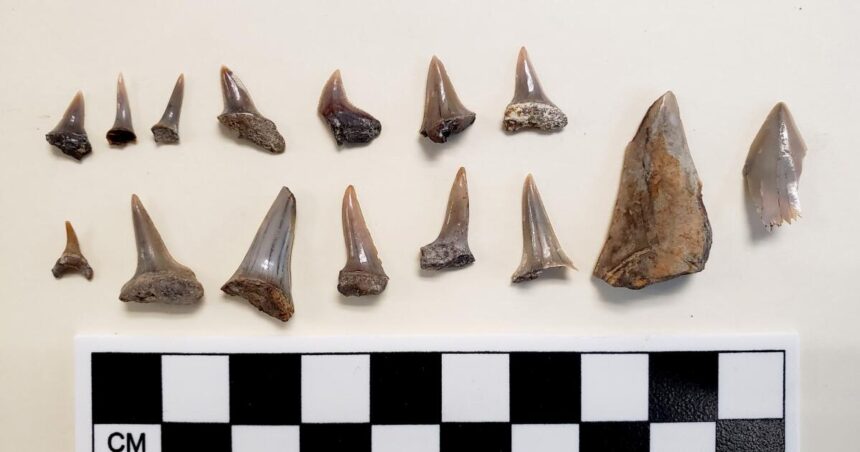Beneath the concrete of San Pedro High School, construction workers have discovered a buried secret: thousands of marine fossils that tell the story of the Palos Verdes Peninsula’s ancient geologic past.
The researchers found two separate sites on the campus, where a new building was under construction: an 8.7 million-year-old bone bed from the Miocene epoch, and a shell bed from the Pleistocene epoch that is about 120,000 years old.
Now that construction is complete, scientists are turning their attention to what they can learn from fossils that date back millions of years.
“Never before has this density of fossils been found in a place like this in California,” said Wayne Bischoff, director of cultural resources for Envicom, which managed the collection of excavated fossils. “This is the largest underwater bone bed ever found in Los Angeles and Orange counties.”
Bischoff said the marine fossils are consistent with what researchers already knew: For most of Los Angeles’ geological history, the land was underwater.
“We’re kind of like detectives,” says geologist Richard Bales of Long Beach State University.
Bales is testing the chemical and mineral composition of the fossil chunks in the hopes that scientists can learn more about these prehistoric environments, such as the atmosphere and conditions that allowed animals to fossilize. “We have to find clues and then piece those clues together.”
The Miocene fossils were encased in fossilized algae called diatomaceous earth. Bales said the diatomaceous earth suggests the area was rich in algae and nutrients, supporting a complex ecosystem that included dolphins, fish and whales that flocked to it to feed. Bischoff said he was excited to find an entire coastal ecosystem, including a sandpiper skull and pieces of driftwood in the bone bed, in addition to the marine animals.
“Once we started noticing the coastal material mixed in, we started to wonder if there was a dead island offshore,” Bischoff said.
Bischoff hypothesizes that during the Miocene, violent storms washed plant and animal remains from a prehistoric island into an underwater canyon, and then the mud trapped the organic matter in sedimentary layers. Millions of years later, tectonic shifts and falling sea levels allowed the fossils to be discovered.
“After their experience here,[scientists]started looking for other extinct islands,” Bischoff says. “It seems likely that there were many islands in the Channel Islands region that formed and then disappeared.”
The campus has completed construction of new buildings, and Bischoff said 80 percent of the fossil blocks discovered in 2022 have been turned over to research and education institutions. The fossils are now split between the Los Angeles Unified School District, Cabrillo Marine Aquarium, California State University Channel Islands and the Natural History Museum of Los Angeles County.
This summer, Austin Hendy, assistant curator of invertebrate paleontology at the Natural History Museum, spent hours sifting through and sorting the thousands of shell fossils found in the bed.
The discovery inspired at least one high school student to study the past as a way to understand the present.
“It was like gold mining,” said Milad Esfahani, a San Pedro High School student who helped Hendy sort the fossils by size. “My job was to look for the tiny fossils, about one-eighth to one-sixteenth of an inch in size.”
This was the first time Milad, a 17-year-old high school senior, had ever held a 125,000-year-old fossil in his hands. He plans to apply to colleges this fall and hopes to study marine paleontology in college.
The Natural History Museum has not announced plans to display the fossils found beneath the school, but it already has a marine paleontology section called “LA Underwater.”
Hendy hopes to work with another student to organize an exhibit at San Pedro High School next summer as part of an effort to educate and engage the public about Los Angeles’ prehistoric history.
“Discoveries will continue to be made; these blocks are eroding very slowly,” Hendy said of the fossil blocks retrieved from the school. “We hope that in the future students and members of the public will be able to climb these rocks and be inspired by what they find.”
While the work is painstaking and may seem pedantic to others, scientists like Baer are drawn to it because it reveals how Earth’s 4.54 billion-year history still shapes our present.
“This is a real window into what the ocean and land landscape was like at the time this event happened,” Bales said. “It seems like a long time ago, but it really has influenced everything we have today.”
In fact, many Los Angeles residents rely on fossil fuels to run their daily errands; fossil fuels are what fuel our gas tanks.
“The diatoms in the diatomaceous earth gave birth to the oil, automotive and aviation industries in Los Angeles,” Hendy says. “The history of this city is thanks to geology.”









